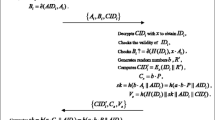Abstract
Telecare Medicine Information Systems (TMIS) promote the traditional medical and healthcare services by information and communication technology. Since the physician and caregiver can monitor the patient’s physiological condition remotely in TMIS, the confidentiality of this sensitive data should be protected, which is the key issue in the Health Insurance Portability and Accountability Act. In this paper, we propose an efficient certificateless public key encryption scheme without bilinear pairing for TMIS. Our proposal is proved to be secure in the random oracle model under the hardness assumption of computational Diffie-Hellman problem. Moreover, after modifying the original model of the certificateless encryption, this scheme achieves Girault’s trust level 3. Compared with the related protocols, the perform evaluations show that our scheme is more efficient and appropriate to collocate with low power mobile devices for TMIS.



Similar content being viewed by others
References
Wu, Z.-Y., Lee, Y.-C., Lai, F. P., Lee, H.-C., and Chung, Y. F., A secure authentication scheme for telecare medicine information systems. J. Med. Syst. 36:1529–1535, 2012.
Health Insurance Portability and Accountability Act of 1996, 104th Congress. Public Law 104–191, 1996
Lee, W. B., and Lee, C. D., A cryptographic key management solution for HIPAA privacy/security regulations. IEEE Trans. Inf. Technol. Biomed. 12(1):34–41, 2008.
Al-Ameen, M., Liu, J. W., and Kwak, K., Security and privacy issues in wireless sensor networks for healthcare applications. J. Med. Syst 36:93–101, 2012.
Shamir, A., Identity-based cryptosystems and signature schemes. Proc. Adv. Cryptology 84:47–53, 1985.
Boneh, D., and Franklin, M., Identity based encryption from the Weil pairing. Proc. Adv. Cryptology 01:213–229, 2001.
Oh, J. H., Lee, K. K., and Moon, S. J., How to solve key escrow and identity revocation in identity based encryption schemes. Proc. First International Conference on Information System Security, 290–303, 2005.
Al-Riyami, S. S., and Paterson, K. G., Certificateless public key cryptography. Proc. Adv. Cryptology 03:452–473, 2003.
Libert, B., and Quisquater, J. J., On constructing certificateless cryptosystems from identity based encryption. Proc. Public Key Cryptography, 474–490, 2006.
Huang, Q., and Wong, D. S., Generic certificateless encryption in the standard model. IWSEC 278–291, 2007.
Dent, A. W., Libert, B., and Paterson, K. G., Certificateless encryptions strongly secure in the standard model. Proc. PKC’08, 344–359, 2008.
Sun, Y. X., and Li, H., Short-ciphertext and BDH-based CCA2 secure certificateless encryption. Science China: Information Science 53:2005–2015, 2010.
Baek, J., Safavi-Naini, R., and Susilo, W., Certificateless public key encryption without pairing. Proc. ISC’05, 134–148, 2005.
Lai, J. Z., Kou, W. D., and Chen, K. F., Self-generated-certificate public key encryption without pairing and its application. Information Sciences 181:2422–2435, 2011.
Girault, M., Self-certificated public keys. Proc. EUROCRYPTO 91:490–497, 1992.
Scott, M., Miracl library, Available from: http://certivox.com/.
Miyaji, A, Nakabayashi M, Takano S. New explicit conditions of elliptic curve traces for FR-reduction. IEICE Transactions on Fundementals, E84-A, 2001.
The Certicom Corporation, SEC2: Recommended domain parameters, Version 1.0, 2000.
Acknowledgments
This work is supported by NSFC (Grant Nos. 61272057, 61202434, 61170270, 61100203, 61003286, 61121061), the Fundamental Research Funds for the Central Universities (Grant No. 2012RC0612, 2011YB01).
Conflict of interest
The authors declare that we have no conflict of interest.
Author information
Authors and Affiliations
Corresponding author
Rights and permissions
About this article
Cite this article
Guo, R., Wen, Q., Shi, H. et al. An Efficient and Provably-Secure Certificateless Public Key Encryption Scheme for Telecare Medicine Information Systems. J Med Syst 37, 9965 (2013). https://doi.org/10.1007/s10916-013-9965-0
Received:
Accepted:
Published:
DOI: https://doi.org/10.1007/s10916-013-9965-0




